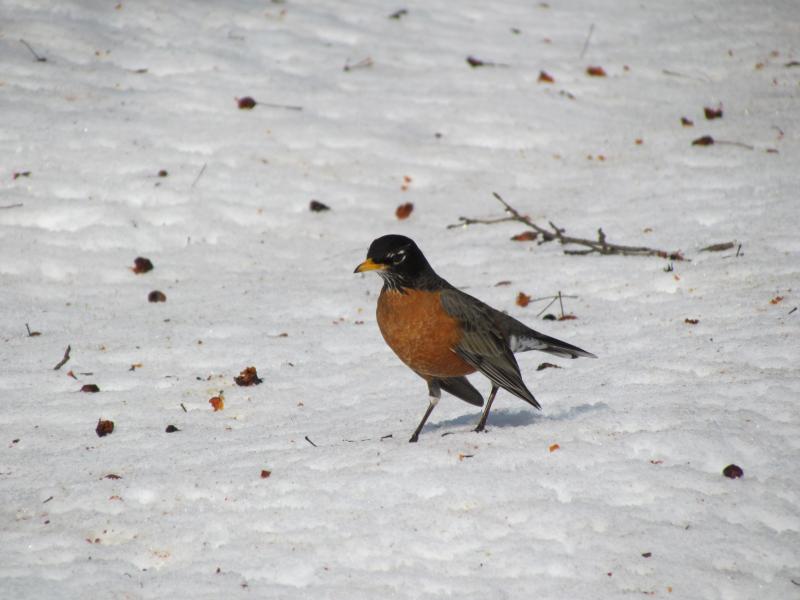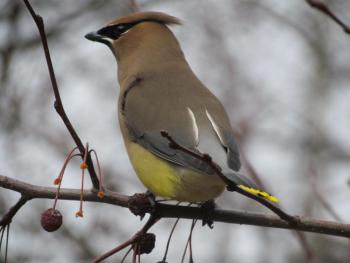Stella Returns in Time for the Great Backyard Bird Count
We don’t want to sound too boastful but it appears our prediction about where the Steller’s sea-eagle was going to be seen again was right. A few columns ago (https://www.boothbayregister.com/article/sea-eagle-invisibility-shows-why-study-bird-movements-not-easy/156499) we laid out a rationale based on a study of the species in its native range, for why we might expect the bird to be found within about 20 miles in any direction from Boothbay Harbor. Whether or not our conjecture made any sense, Stella, as folks have begun calling the famous Steller’s sea-eagle, was apparently found again on Sunday about seven miles (as the crow, er, sea-eagle flies) from Boothbay Harbor.
While Stella was hiding out for the last three weeks, other birds have not been so shy.
We have been seeing an influx of larger numbers of fruit-eating birds—American robins and cedar waxwings mostly, along with a few eastern bluebirds. Interestingly, we have not seen any of the larger Bohemian waxwings, with their distinctive and hard-to-miss rusty undertails, among the cedar waxwings, nor have many been reported overall in Maine as of this writing.
We have been watching the robins closely, though, in the vain hope that a super rare wayfaring European relative like a fieldfare or redwing might be among them. Some of you may remember that it was only a year ago about this time when Maine’s second redwing was gazed at by hundreds of birders down in Capisic Park in Portland, including ourselves, which we wrote about here. And Maine’s first and only fieldfare was hanging out with a large flock of robins when it spent April of 2017 in Newcastle.
Maybe we should also be scanning those robin-sized thrushes for a wandering bird of the West Coast—the handsome varied thrush sporting its orange eyebrows. While still a rarity here (the closest they nest to Maine is in western Montana), there are multiple records. In January and February of this year, individuals have been found in Massachusetts, New Hampshire, and New Brunswick. A number of varied thrushes have been in Quebec as well, including one only about twenty miles from Maine’s northernmost border.
On the recent warm days, we also have been enjoying a bit of a spike in singing activity. Tufted titmice have been loudly proclaiming “peter, peter” back and forth across invisible territorial boundaries in the neighborhood. Yesterday, despite a return back to the cold temps again, a house finch was bursting with song. On one of our dog walks, we were delighted to hear the rollicking “tea-kettle, tea-kettle, tea-kettle” song of a Carolina wren a few blocks away.
Some of the songs have been more subdued. A robin gave just a few seconds of that cheerful song of spring one day last week as though testing out the vocal apparatus just to make sure it would be ready when the time was really right in a month or two. One of the two or three song sparrows that have wintered in and around our backyard has haltingly sung a few short phrases in the mornings. On the other hand, we have not heard even a whisper of the “old-sam-peabody” song from any of the white-throated sparrows that have also wintered at our home, nor a faint trill from the dark-eyed juncos here either.
All of these birds and any that you see can be reported for the next Great Backyard Bird Count, taking place from February 18-21. As some readers may remember, we were involved in the very first Great Backyard Bird Counts and have been great supporters ever since. We hope you will take a few moments and submit one or more of your sightings to the count at birdcount.org.
Jeffrey V. Wells, Ph.D., is a Fellow of the Cornell Lab of Ornithology and Vice President of Boreal Conservation for National Audubon. Dr. Wells is one of the nation's leading bird experts and conservation biologists and author of the “Birder’s Conservation Handbook.” His grandfather, the late John Chase, was a columnist for the Boothbay Register for many years. Allison Childs Wells, formerly of the Cornell Lab of Ornithology, is a senior director at the Natural Resources Council of Maine, a nonprofit membership organization working statewide to protect the nature of Maine. Both are widely published natural history writers and are the authors of the popular books, “Maine’s Favorite Birds” (Tilbury House) and “Birds of Aruba, Bonaire, and Curaçao: A Site and Field Guide,” (Cornell University Press).


























